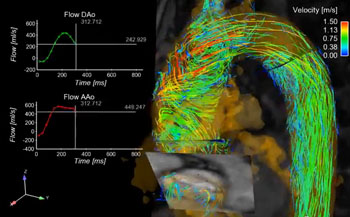4D Blood Flow MRI Technology Detects Aortic Disease and May Predict Complications
By MedImaging International staff writers
Posted on 24 Feb 2014
A new imaging technique developed for measuring blood flow in the heart and vessels has been shown to identify a common congenital heart abnormality, bicuspid aortic valve, and may lead to better prediction of complications. Posted on 24 Feb 2014
The investigators published their findings February 11, 2014, in the journal Circulation, and demonstrated for the first time a previously unknown connection between heart valve abnormalities, blood flow alterations in the heart, and aortic disease. They revealed that blood flow changes were fueled by specific types of abnormal aortic valves, and they were able to tie blood flow patterns to aortic diseases directly.

Image: 4D flow MRI used to enhance heart disease prediction capabilities (Photo courtesy of Northwestern University Feinberg School of Medicine).
“Blood flow in patients with bicuspid aortic valves was significantly different compared to that in patients with normal valves,” said senior author Dr. Michael Markl, associate professor of radiology at Northwestern University Feinberg School of Medicine (Chicago, IL, USA). “We now have direct evidence that bicuspid valves induce changes in blood flow and that the type of flow abnormality may contribute to the development of different expressions of heart disease in these patients.”
A Bicuspid aortic valve is a most common congenital cardiovascular abnormality, a heart disorder in which the aortic valve only has two leaflets, instead of the normal three. In spite of absence of symptoms, it can lead to significant and potentially life-threatening complications, including enlargement of the blood vessel, which results in aneurysm formation and rupture. However, it is not known which patients are at the highest risk for complications and whether the disorder’s origin is genetic or associated with changes in blood flow.
The four-dimensional (4D) flow magnetic resonance imaging (MRI) technology used in the study can provide better predictive ability. “The study demonstrated that new imaging techniques may help to determine patient-specific changes in blood flow to better understand which regional areas of the aorta are most prone to developing disease,” Dr. Markl said. “In addition, the knowledge of abnormal blood flow patterns could be important to better identify patients at risk for the development of heart disease.”
The researchers were amazed to see such an obvious distinction between different expressions of aortic complications for different types of congenital valve disease. Whereas these new findings show evidence of this relationship, long-term observational studies are required, according to the investigators, for a better determination of the potential of 4D flow MRI to enhance disease prediction capabilities.
A longitudinal follow-up study of bicuspid aortic valve patients is ongoing at Northwestern. “Ultimately, we hope that this imaging technique will facilitate early identification of high-risk blood flow patterns associated with progressive aortic enlargement, improving the allocation of health care resources in caring for patients with this prevalent condition,” Dr. Markl concluded.
Related Links:
Northwestern University Feinberg School of Medicine













.jpg)
